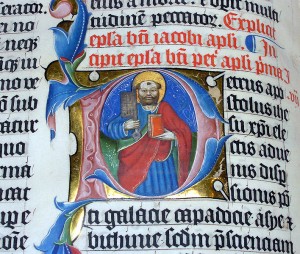 The seven Catholic Epistles written by Saints James, Peter, John, and Jude form a small but integral portion of the New Testament. These letters have always interested me, ever since I learned about the epistolary genre of Scripture when I was a boy at Catholic school. I wonder how much attention these writings receive, written as they were by the friends and family members of Jesus. As a preacher it has always been my purpose to proclaim the Word of God through these letters so that the Catholic souls in my care may know more about Divine Revelation as rendered by these memoirs of the Apostles.
The seven Catholic Epistles written by Saints James, Peter, John, and Jude form a small but integral portion of the New Testament. These letters have always interested me, ever since I learned about the epistolary genre of Scripture when I was a boy at Catholic school. I wonder how much attention these writings receive, written as they were by the friends and family members of Jesus. As a preacher it has always been my purpose to proclaim the Word of God through these letters so that the Catholic souls in my care may know more about Divine Revelation as rendered by these memoirs of the Apostles.
Can biblical epistles be memoirs? They are two distinct literary forms. A memoir is a true story, a slice-of-life autobiography, that centers on a specific time, place, or person of interest to the author. The realm of these letters is the first century after the birth of Christ. The place is the Roman Empire in which the Church grew quickly into a worldwide portal of salvation. The person from which the epistoleers James, Peter, John, and Jude took their inspiration is Jesus Christ. James, Peter, John, and Jude all write about Jesus but to different communities and in different ways. How many books have been written about Elvis or the Kennedys? Too many yet they all make the best-seller list.
From the beginning letters have always been important to the faith. Most of the New Testament—21 of the 27 books—is comprised of letters, early Christian missives addressed to churches throughout the world for the first generation of Christians and for the Church today. Justin Martyr (AD 100-165) was a Christian apologist and a convert to the faith and he wrote a description of the Mass in which he described the sacred writings of the Liturgy of the Word—the readings, the psalms, and the gospels—as the ‘memoirs of the apostles.’ Through these personal writings the authors of the gospels and the letters continued to keep the memory of Jesus Christ alive until he returned. The authors of the New Testament all drew upon their personal experiences with Jesus before and after the resurrection as the inspiration for their holy writings.
In these epistles are tell-all books in which the Apostles bare their souls and shed light on a special time and in a certain place when the Word walked among us in living color and three-dimensional. Jesus was the fulfillment of the ancient promise of eternal salvation by God the author of history and life.
I write of what was from the beginning, what we have heard, what we have seen, what we have looked upon, and what we have touched with our hands: the Word of Life (1 Jn 1:2a).
The lives of the Apostles, their ministry, their martyrdoms, provide the soul of their work. It is necessary to examine their work through traditional exegesis but also to illuminate them as works of literature, as are all the sacred books in the Bible. These letters contain enduring Christian doctrine but they are also great works of prose, written by the men who knew Jesus personally and who in composing their stories looked back on the time they spent with him during his three-year ministry. As they wrote the saints recalled the great and surreal days when they helped the Lord to build the kingdom of heaven on earth. Peter relived the night he saw Jesus transfigured on the mountain. James led his followers with the authority that he learned listening to Jesus preach sermons on the kingdom. John was with Jesus constantly and expressed his love for the Lord in his gospel, three letters, and the Apocalypse. Jude, who like James was a relative of Jesus, stood close enough to God to describe the gate of heaven.
In the ancient world letters were a necessary and important means of communication: kings wrote to their subjects. Soldiers responded to missives sent out by their commanders. Church leaders in the Apostolic Age wrote encyclicals to congregants to establish and maintain unity and authority among Christians scattered throughout the world.
God gave us the ability to express ourselves to one another with words. “In the beginning, when God created the heavens and the earth, the earth was a formless wasteland, and a great wind swept over the abyss. Then God said:‘Let there be light.’ And there was light” (Gn 1:1-3). Jesus Christ the only Son of the Father is the true light of the world. God spoke into the darkness and created the light and this Word of Life is the light of the human race (Jn 1:3b), an endless source of inspiration. The Apostles took up their pens and issued a continual stream of praise for God and an invitation to readers everywhere to join them in building the kingdom.



